Pizza is one of those dishes that many eat year-round. However, if you have kidney disease and are worried about the potassium in pizza, you may think of skipping it. But don’t worry! In this article, we will provide you with helpful tips on how to enjoy pizza on a renal diet! Who’s ready to enjoy a slice of ooey-gooey pizza, guilt-free?
This article was written by dietetic student Natalie Rodriguez and medically reviewed by Jen Hernandez RDN, CSR, LDN.
*This article contains affiliate links in which we earn a small percentage of sales at no expense to you. We only ever provide affiliate links for products that we truly believe in and recommend for both ourselves and kidney warriors. Thank you for your support!
Table of Contents
What is potassium?
Potassium is a very important mineral in the body.
In fact, potassium is the third most abundant mineral.
It plays many critical roles. Some of these roles include;
- fluid balance
- nerve signaling
- heart rhythm
- muscle contractions
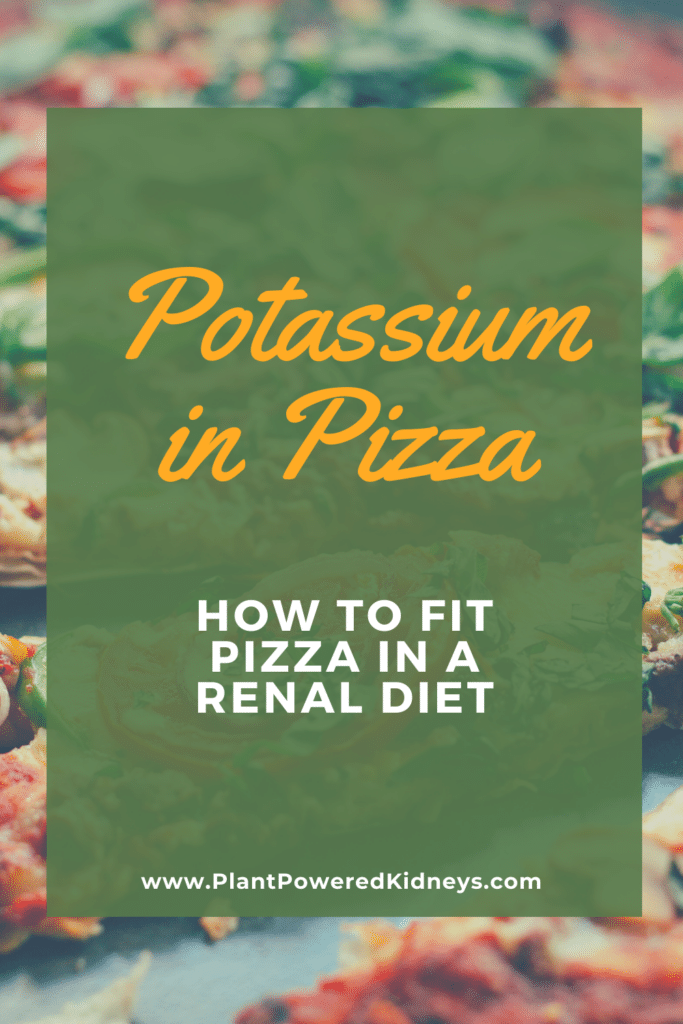
Why is potassium so important for a kidney patient?
The main role of kidneys is to filter out waste products.
However, the kidneys may not be able to filter out waste products.
This happens with chronic kidney disease (CKD).
With CKD, poor filtration can lead to high levels of potassium in the body.
Some of the symptoms of this are;
- fatigue
- nausea
- irregular heartbeat
- abnormal pulse
At the same time, there are some bad effects of having low potassium in the body as well.
Therefore, it is important to aim for normal levels of potassium in the body.
That way, potassium can perform its key roles.
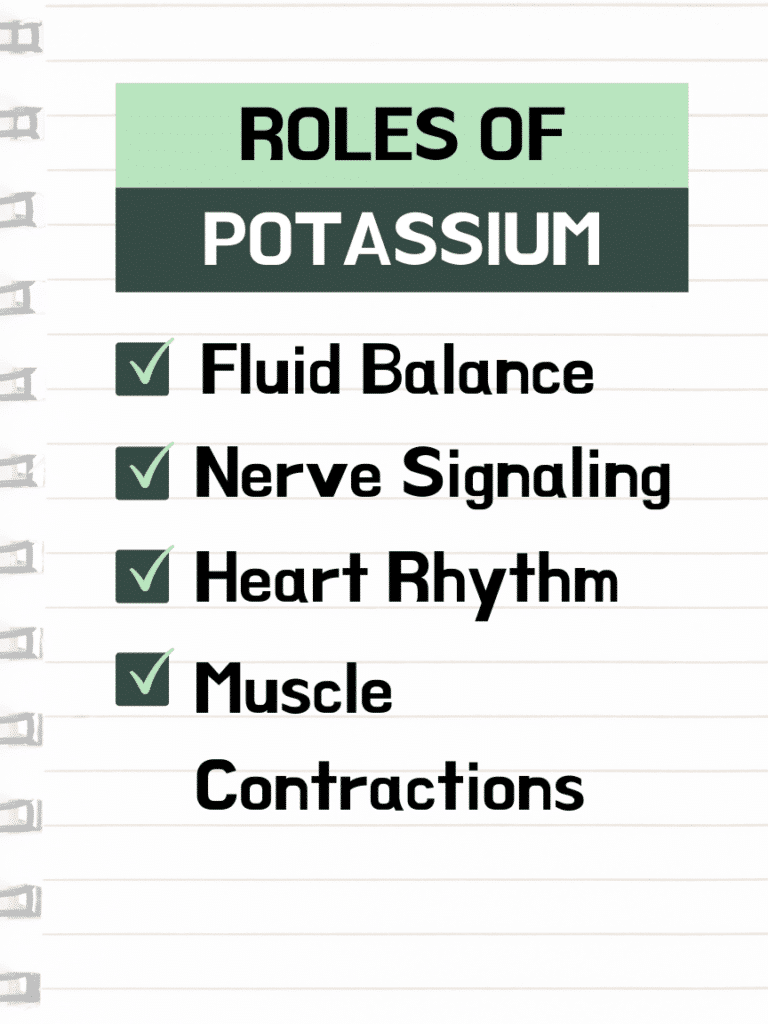
What is considered high and low potassium?
A high potassium food will have more than 200 milligrams (mg) per serving.
However, it is considered to be a low potassium food if it has less than 200 mg of potassium.
Potassium additives
Potassium additives are a concern for those on a low potassium diet. This is because additives are highly absorbed into the bloodstream.
It is important to look out for these additives in the ingredient lists for a food.
Common potassium additives include:
- Potassium chloride
- Potassium sorbate
However, not everyone with kidney issues needs to avoid potassium additives.
It’s recommended to practice reading labels to find potassium additives. This is especially important when told to limit potassium.
You can read more about potassium here.
Is Pizza High in Potassium?
The short answer to this is no.
A slice from a 14” cheese pizza has approximately 184 milligrams of potassium.
But that is where that answer ends.
A slice of 14” pepperoni pizza has about 216 milligrams of potassium.
This is higher than the low potassium guideline discussed above.
And a slice from a 14” supreme pizza has around 250 milligrams of potassium.
The next section will cover details about potassium in pizza ingredients.
This will help you learn more about the potassium in pizza and how it can fit into your renal diet.
Potassium in Pizza Ingredients
While there can be low potassium pizza and ingredients, it’s important to be aware of high potassium ingredients.
First, let’s talk about the potassium in pizza dough and in pizza crust.
Pizza Dough & Pizza Crust
Most pizza doughs are made out of flour. Some flours will have more potassium than others.
Some of the highest potassium flours include almond flour and whole wheat flour.
The lowest potassium flours are gluten-free flour and all-purpose flour.
There are so many pizza crust options to choose from.
Some brands we have found that have additive-free pizza crust options include:
Here are some brands to be aware of that have potassium and/or potassium additives:
- Pillsbury
- Signature Select
- Great Value
These pizza crusts do not have high potassium levels. However, they may use a potassium additive, like potassium chloride.
High Potassium Pizza Crusts Table
Below is a table of some commonly found pizza crust brands and the amount of potassium that is listed in the nutrition facts.
Potassium additives are also highlighted if they are found in the ingredients list.
| Pizza Crust Brand | Type of Pizza Crust | Potassium (milligrams) per serving | Potassium additives? |
| Pillsbury Classic Pizza Crust | Refrigerated | 220 | Yes |
| Signature Select Pizza Crust | Refrigerated | 130 | Yes |
| Great Value Pizza Crust | Refrigerated | 130 | Yes |
However, not all pizza crusts are high in potassium.
Let’s look at some low potassium pizza crust options in the table below.
Low Potassium Pizza Crusts Table
| Pizza Crust Brand | Type of Pizza Crust | Potassium (milligrams) per serving | Potassium additives? |
|---|---|---|---|
| Simple Truth Organic™ Classic Thin & Crispy Vegan Pizza Crusts | Shelf-stable | n/a | No |
| Safeway Signature Select | Shelf-stable | 130 | Yes |
| Mama Mary’s 12” Pizza Crust | Shelf-stable | 60 | Yes |
| Golden Home Ultra-Thin 12” Pizza Crust* | Shelf-stable | 90 | No |
*Golden Home falls under low potassium restrictions.
Pizza Sauce
There are many different options when it comes down to choosing the pizza sauce.
However, knowing which sauces are high or low in potassium may help with the decision-making.
| High Potassium Pizza Sauce Options | Lower Potassium Pizza Sauce Options |
| Marinara sauce Tomato sauce Alfredo sauce | Roasted red pepper sauce BBQ sauce Olive oil Pesto Buffalo sauce |
Cheese
Although cheese does not contain alarming amounts of potassium, it should still be recognized as another source of potassium in pizza.
For every one ounce of cheese, there is about an average of 35 milligrams of potassium.
Processed cheese like the cheese-in-a-can products are high in potassium. However, some low potassium cheese options include:
- Parmesan cheese
- Ricotta cheese
- Mozzarella cheese
- Romano cheese
- Feta cheese
| Description | Serving | Potassium (mg) Per Serving | Protein (g) Per Serving | Sodium (mg) Per Serving | Phosphorus (mg) Per Serving |
|---|---|---|---|---|---|
| Parmesan cheese | 1 oz | 35 | 11 | 433 | 178 |
| Ricotta cheese (whole milk) | 1 oz | 29 | 3 | 24 | 45 |
| Mozzarella cheese (part-skim), aka string cheese | 1 oz | 27 | 8 | 4 | 149 |
| Feta cheese | 1 oz | 18 | 4 | 316 | 96 |
| Provolone cheese | 1 oz | 39 | 7 | 245 | 141 |
| Romano cheese | 1 oz | 24 | 9 | 340 | 215 |
| Goat cheese | 1 oz | 7 | 5 | 130 | 73 |
| Gorgonzola | 1 oz | 73 | 6.1 | 325 | n/a |
| Vegan cheese | 1 oz | 129 | 3.3 | 194 | varies |
A medium pizza has around 6-7 ounces of cheese, depending on where it’s from.
Putting this into perspective, a pizza with mozzarella cheese (27 mg per 1 ounce) will have around 162 mg of potassium.
Since this is below 200 mg, mozzarella cheese can be considered a good choice for pizza.
However, a simple option is to ask for light cheese. This can help lower the potassium on the pizza.
Click here for more information about the potassium in cheese.
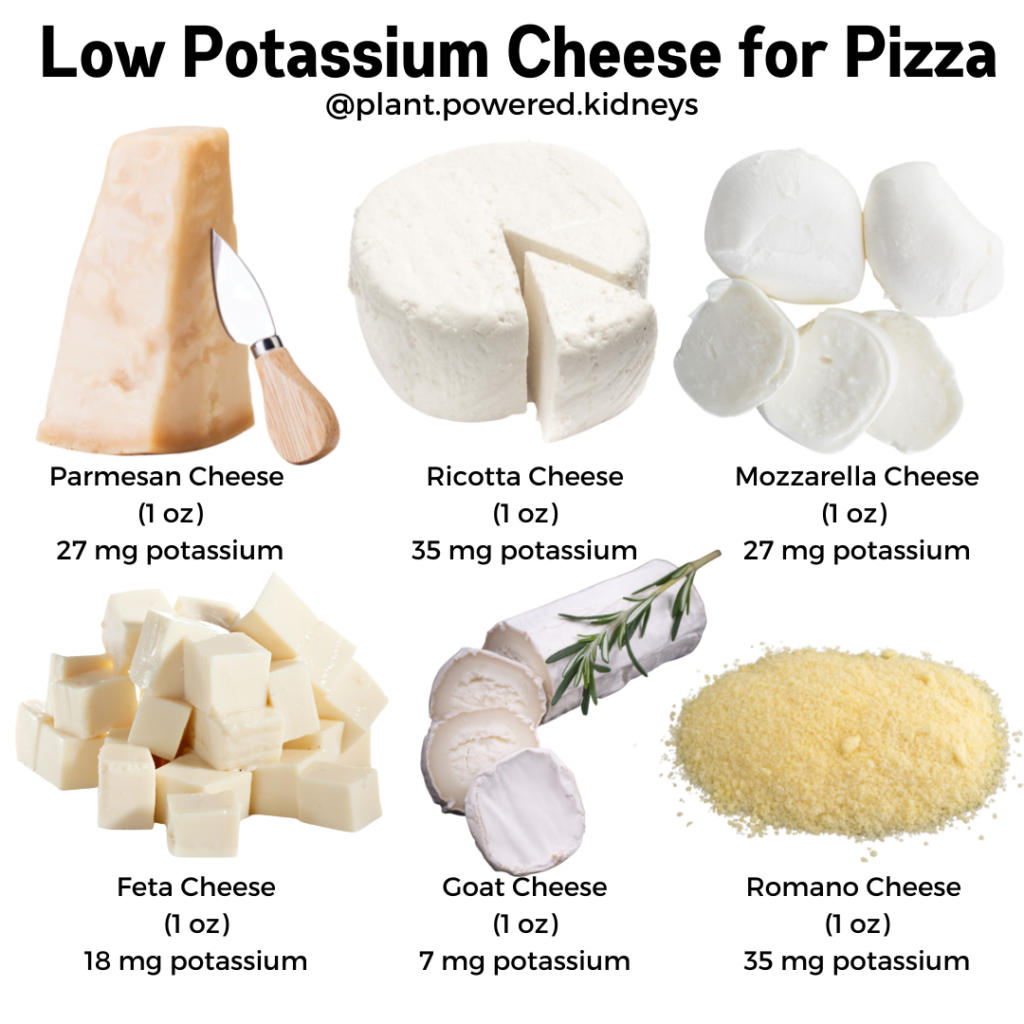
Meat Toppings
It may be surprising that meat adds to the potassium in pizza.
Processed meats are high in potassium. This can include pizza toppings such as:
- Pepperoni
- Ham
- Bacon
- Canadian bacon
- Chicken
- Italian sausage
- Ground beef
- Salami
- Meatballs
While most pizzas will not have large amounts of meat, they can still add potassium to pizza.
Learn more about the potassium in meat here.
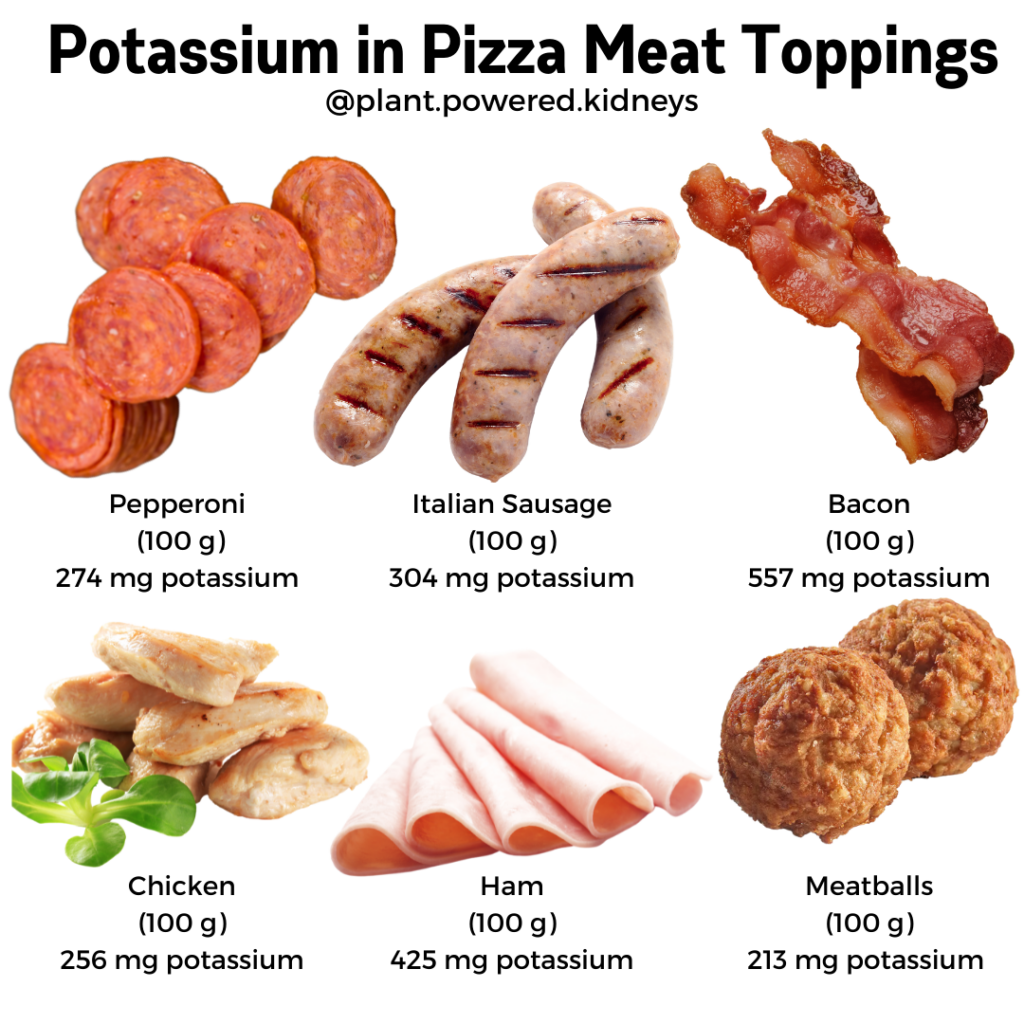
Veggie Toppings
Although vegetables are relatively high in potassium, there are some that have lower potassium.
| High Potassium Vegetable Options | Lower Potassium Vegetable Options |
| Artichokes White Mushrooms Spinach Tomatoes Potatoes | Arugula Fresh basil Olives (black, kalamata, green) Garlic Bell peppers Jalapenos Pineapple* Onion Fresh rosemary |
*Although pineapple is not a vegetable, it is a common pizza topping and it is low in potassium.
As mentioned earlier, even low potassium vegetables can add to the potassium in pizza.
To keep your potassium amount low, it is best to limit to 4-5 toppings.
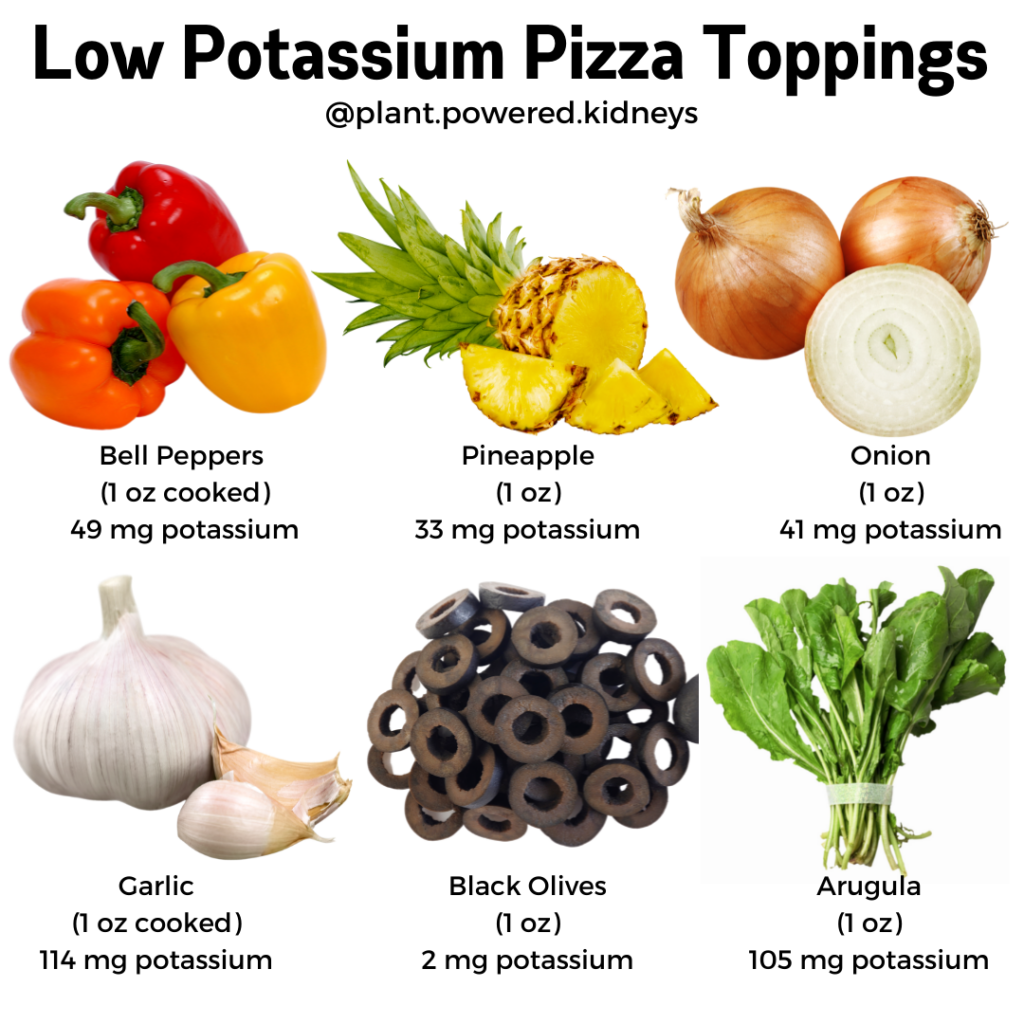
Low Potassium Take-out Pizza
Take-out pizza is another option. However, keep in mind that the potassium in pizza can truly add up quickly when the pizza is made outside of the home.
Below are some examples of potassium in several different pizza restaurants.
| Brand | Type of Pizza | Potassium per slice from 14” pizza |
|---|---|---|
| Papa Johns | Cheese | 161 |
| Pepperoni | 184 | |
| Supreme | 245 | |
| Dominos | Cheese | 174 |
| Pepperoni | 207 | |
| Supreme | 188 | |
| Pizza Hut | Cheese | 192 |
| Pepperoni | 228 | |
| Supreme | 256 |
Information for potassium content of take-out pizzas was obtained from the USDA Food Database.
It is important to note the amount of potassium in Domino’s supreme pizza as it isn’t as high compared to other brands.
Frozen Pizza
Frozen pizza is a great money and time saver. However, these processed and preserved pizzas may be higher in sodium and phosphorus.
Spend some extra time in the frozen aisle to do some research and label reading.
Here are some examples of frozen pizzas that can fit into a renal diet. Both swaps are low in potassium!

Here’s another comparison.
Here, we can see the differences between a “regular” pepperoni pizza versus a plant-based pizza option.
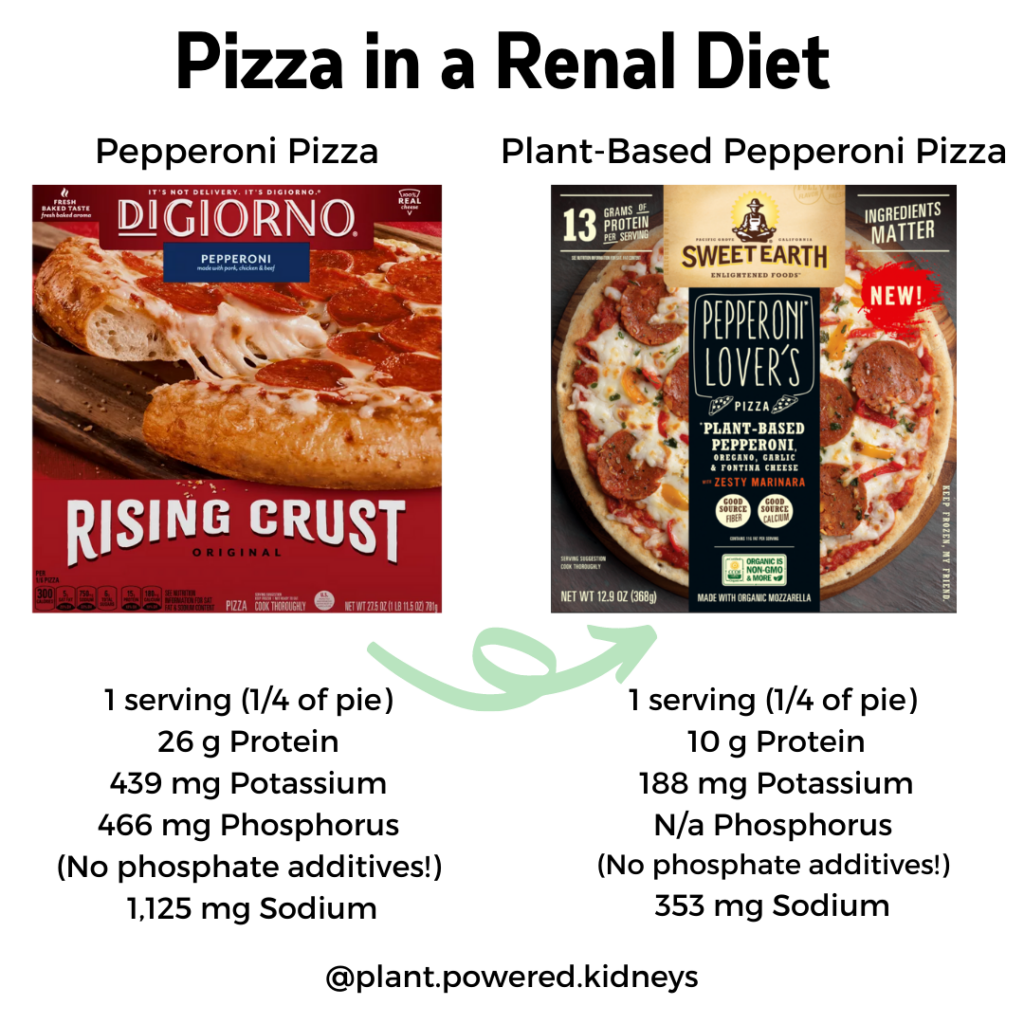
How surprising is it to see the difference in potassium with a plant-based swap?
How to Fit Pizza into a Low Potassium Renal Diet
While it’s important to consider potassium in pizza, there are other nutrients that people with kidney disease need to pay attention to.
Include as a part of a balanced meal
Pizza alone rarely makes for a filling meal. That is unless a person eats multiple servings.
To keep the potassium low in a meal with pizza, try including a side salad and olive oil-based dressing.
This will help fill you up with extra fiber and healthy fats that will keep you feeling full for longer.
Enjoy in moderation
While it may be easier to see how pizza can fit into a low potassium or kidney-friendly diet, it’s equally important to know that it’s not the foundation of a healthy diet.
Enjoy pizza at a party or event where pizza is offered. However, it’s not recommended to have pizza multiple times every week.
Leftover pizza can be frozen! Simply reheat when ready to enjoy another slice of pizza later on.
Sodium in Pizza
Not only is the potassium in pizza important to consider, but the sodium is equally as important.
The recommended daily value of sodium for a CKD patient is below 2,300 mg per day.
The average amount of sodium in a slice of pizza can be over 760 mg.
This means that two slices can account for two-thirds of the day’s worth of salt.
A reason for this high level of sodium is due to the highly processed meats that are included in pizzas. The most common is pepperoni.
A great alternative would be swapping pepperoni for more veggies.
Phosphorus in Pizza
Another important mineral to look out for in pizza is phosphorus.
For an individual with less kidney function, there is no set daily value recommended.
It is specialized for each individual, which can be discussed with a doctor or renal dietitian.
By the same token, phosphorus should be avoided as much as possible.
A way to do this is to look at the ingredient list and look for any phosphate additives.
These are always labeled with a substance and then the word “phosphate” after (e.g. sodium phosphate).
Another way to avoid phosphorus is by making your own pizza dough.
Instead of using baking powder, which is made of phosphates, it would be better to use a mixture of cream of tartar and baking soda.
This mixture serves as a kidney-friendly baking powder.
Does the Potassium in Pizza Make a Difference?
Yes, it can!
Frozen and take-out pizzas are always going to have higher amounts of potassium, sodium, and phosphorus.
Not to mention, it is more likely that they will contain ingredients with phosphate additives.
That doesn’t mean that they should be completely restricted, but that they should be eaten in moderation.
If this option is better and more convenient, it would be best to buy the frozen/take-out pizza brands with lower potassium mentioned earlier in the article.
However, the best option would be to make your own kidney-friendly pizza at home.
This can be done by buying the recommended low potassium ingredients listed earlier in the article.
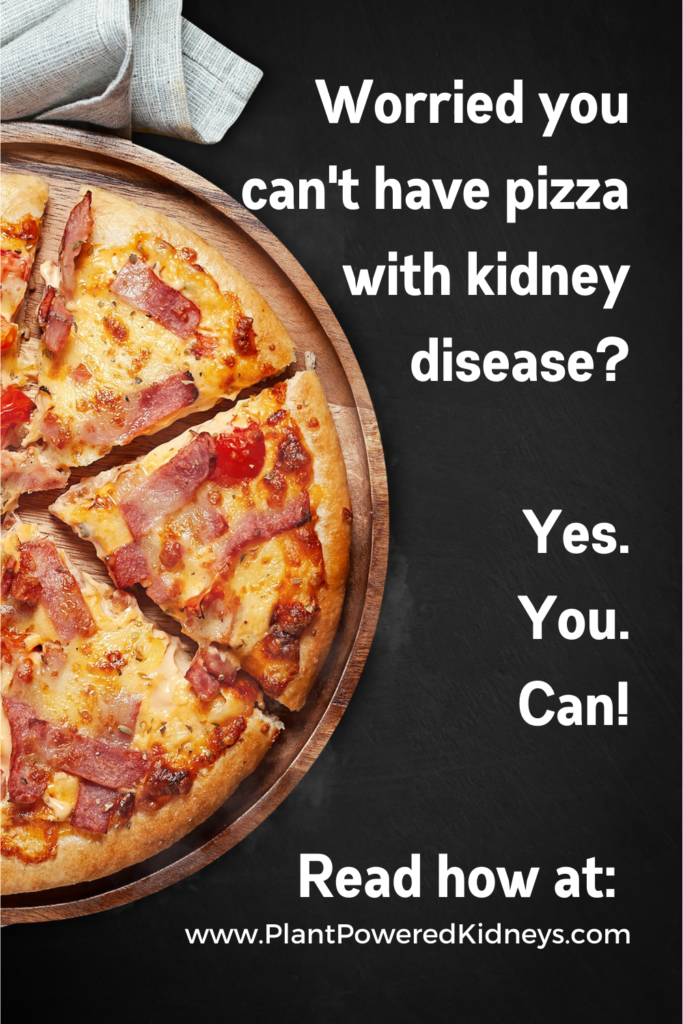

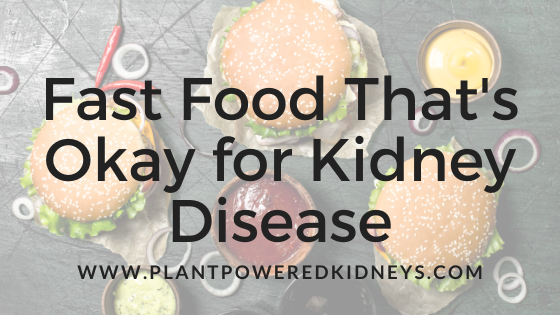
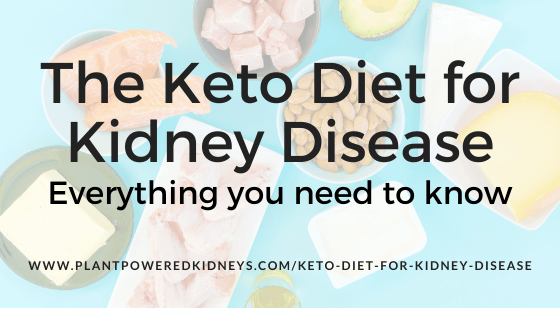
So happy I found this site. I am stage 5 and not on dialysis yet.
We are so happy to have you, Loretta!! 💚
I’m at gfr 51-57 advised to keep salt to 2000/2300. No other restrictions. Would a couple of slices of cheese pizza once a month be o.k.? I check labels.
We can’t say for certain how it would fit into an individuals’ diet, but in general having a couple slices of pizza once a month won’t likely throw anything off significantly. However, it also depends on what else is consumed, and how often, and what labs look like. Our dietitians work with people to figure out this and guide on the best choices so you know what you enjoy without regret. 😊
Added phos is also common in some non-dairy cheese alternatives. (Daiya brand, for example, is notorious for this.) I avoid this by finding a plant based crust with yeast for leavening, and use a thin layer of hummus as a base, then add my veggies. This also avoids the need for tomato sauce, which as you noted is high in potassium. Hope this idea helps someone!
Thanks so much for sharing, Colleen! 🥰 We love a good hummus pizza, too! 😋
Thank you for the article on pizza.
I don’t eat pizza that often but now I know what to look out for.
It’s always fun when we can find more foods to enjoy AND keep our kidneys healthy! 🍕😋
My local Harris Teeter Store has ‘Cauliflower crusted vegetarian pizza’. Is this allowed?
Hi Jane! Cauliflower crust can be a good option, if you enjoy it. Be careful with higher salt and fat content, plus the potential for additives.
I have no restrictions as to what I eat, however, I am still mindful of things because I am not trying to rush my CKD. Occasionally I have a slice of grandma pizza no extra toppings other than the basic that is on it already.
That’s great to be mindful about these things, Chloe. This is key to protecting kidney function. We need to be aware of what to eat and what to be careful with. Good job! 💚
Stumbled on this Plant powered pizza. Stage 3 disease. Restrict renal diet. Have not had pizza since dx. in April. Happened to find this article. What a blessing. Able enjoy pizza finally!!! Thank you so much for valuable information. Like the question/comment for varied experience. Thank you for “expanding our horizons”
Thank you for such useful information! You make it easy to decide what to eat and why it’s thebetter choice. I’m going to try the cream of tartar/ baking soda substitute in other recipes, too.
Aw, so happy to help, Beth! Let us know how it goes. 😊
what brand of gluten free flour was used in this post to show which one was the lowest in Sodium, Phosphates and Potassium? thanks for this great info
This was from the USDA Food database with standardized amounts. King Arthur has one that’s very low in potassium (30mg per serving). There is not phosphorus listed, but also no phosphates in the ingredients, so that’s a win! https://shop.kingarthurbaking.com/items/gluten-free-all-purpose-flour